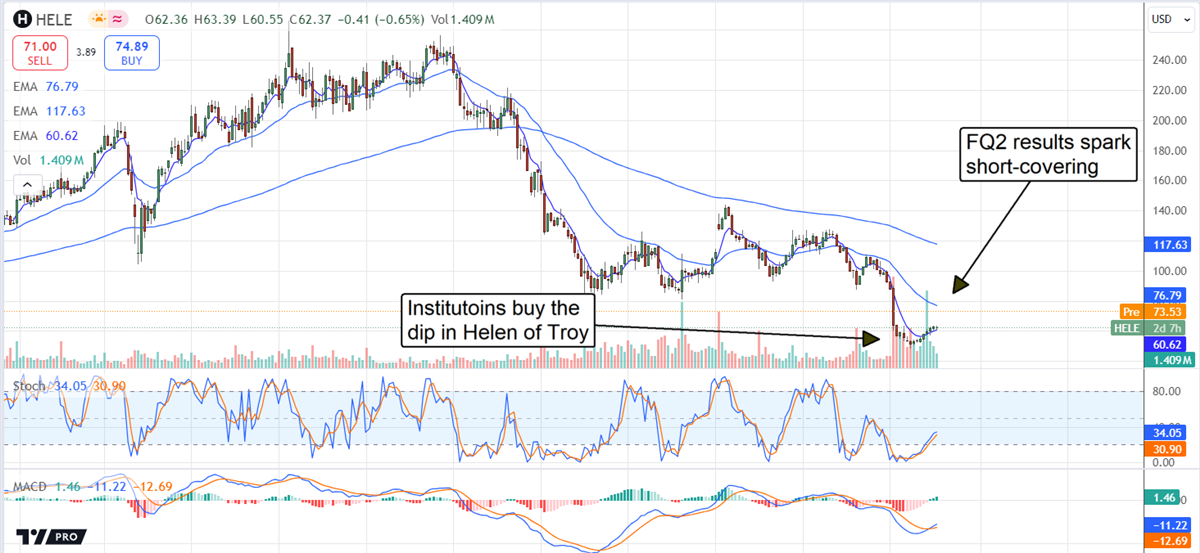Insiders Hold Tight as Helen of Troy Prepares for a Major Rebound
2024.10.11 03:34
- Institutions started buying Helen of Troy in calendar Q3, signaling a bottom for the market.
- High short interest and FQ2 results suggest the rebound could be significant and lead to a sustainable rally.
- Analysts view it as a deep-value, trading beneath their lowest targets.
There is a significant shift in institutional activity for Helen of Troy (NASDAQ:) shares. The institutions shifted from selling to buying in Q3, creating a solid tailwind due to the high interest. Institutions own nearly 99% of this stock, leaving less than 1.5% for insiders, retail investors, and short-sellers. Coincidentally, the short interest is also high, over 10% in the last report and nearly 10% in mid-September, providing ample fuel for a short-covering rally.
The takeaway for investors is that consumer products maker Helen of Troy has hit its market bottom and is now set to rebound. The rebound will likely take time to develop but will deliver sufficient upside to make this investment more than interesting. Trading near a decade low, technical targets for the stock price suggest a nearly 50% upside with a chance for a full reversal. In that scenario, the stock could gain another 50% to 100% over the next few years.
Insider activity is also noteworthy—not because of its volume but because of its lack thereof. Data from Insidertrades.com shows that insiders haven’t sold or purchased this stock since 2023, the last being CFO Brian L. Grass’s purchase. The lack of sales is a sign of insider confidence; investors should not be surprised if insiders start buying shares at such low levels.
Helen of Troy Outperforms in FQ2: Shares Surge
Helen of Troy continues to face challenges, including macroeconomic headwinds and efforts to improve efficiency. However, the Q2 results reflect a positive impact of the company’s global restructuring effort named Project Pegasus. The Q2 revenue is down compared to last year but 330 basis points better than expected, with greater strength on the bottom line. The revenue decline is due to weakness in the Beauty and Wellness segments, offset by Home and Outdoors growth. Home and Outdoors sales grew nearly 1.0% despite negative product mix shifts, while Beauty and Wellness contracted by 7.7%.
Margin news is equally good. The company’s margin contracted at the gross and operational levels in the GAAP and adjusted comparisons but was less than expected. The gross margin fell by 110 bps and the adjusted operating margin by 260, leaving the operating margin at 9.8%. The salient detail is that the 9.8% adjusted margin left the earnings down by double-digits, but the $1.21 in adjusted EPS is 1500 basis points ahead of the consensus estimate, providing sufficient cash flow to sustain operations, reinvestment, and capital return.
Guidance is mixed but indicates a turning point for the business. The company reaffirmed its full-year targets for revenue and earnings, which puts revenue in alignment with the consensus estimate and the EPS midpoint above it. The negative detail is that the free cash flow and debt reduction targets were eased but there is a mitigating factor. Operational challenges at the Tennessee distribution facility impact the cash flow. The automation effort hit snags in Q1, but remediation efforts have been largely completed. The impact on cash flow will end before the fiscal year-end, and automation is expected to drive additional efficiency in calendar 2025.
Helen of Troy Has a Fortress Balance Sheet
Helen of Troy has hurdles to cross but is in a position to do so. The balance sheet highlights include steady assets, declining debt, low leverage, and improving shareholder equity despite debt reduction and capital return. The capital return, in the form of share buybacks, ramped in Q2 compared to last year, reducing the average count by 5%.
The pace of buybacks is expected to continue in F2025 because of the recently announced increase in authorization. The new total is $500 million, which is a tailwind for the market because it is worth 35% of the market cap with shares at a ten-year low. Regarding leverage, total liability, including long-term debt, is about 1x equity.
Following the report, Helen of Troy shares surged nearly 20% in premarket trading. The move suggests that short-covering has begun and a bottom is in play. The critical resistance target is near $75 and the 150-day EMA; a sustained rally may soon form if the market moves above it. If not, the market may become range-bound at current levels until more news is available. 
Original Post








